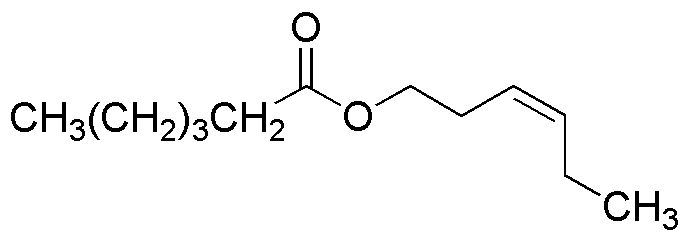cis-3-Hexen-1-yl hexanoate is widely utilized in research focused on:
- Flavoring and Fragrance Industry: This compound is commonly used as a flavoring agent in food products and as a fragrance in perfumes and cosmetics, providing a fresh, green note reminiscent of cut grass or ripe fruits.
- Aromatherapy: Due to its pleasant scent, it is often incorporated into essential oils and aromatherapy products, promoting relaxation and enhancing mood in therapeutic settings.
- Food Preservation: It has potential applications in food packaging materials due to its antimicrobial properties, helping to extend the shelf life of perishable goods.
- Research in Plant Biology: This compound serves as a model for studying plant volatile organic compounds, aiding researchers in understanding plant communication and responses to environmental stress.
- Cosmetic Formulations: Its use in skincare products is growing, as it can enhance the sensory experience of creams and lotions, making them more appealing to consumers.
Informations générales
Propriétés
Sécurité et réglementation
Applications
cis-3-Hexen-1-yl hexanoate is widely utilized in research focused on:
- Flavoring and Fragrance Industry: This compound is commonly used as a flavoring agent in food products and as a fragrance in perfumes and cosmetics, providing a fresh, green note reminiscent of cut grass or ripe fruits.
- Aromatherapy: Due to its pleasant scent, it is often incorporated into essential oils and aromatherapy products, promoting relaxation and enhancing mood in therapeutic settings.
- Food Preservation: It has potential applications in food packaging materials due to its antimicrobial properties, helping to extend the shelf life of perishable goods.
- Research in Plant Biology: This compound serves as a model for studying plant volatile organic compounds, aiding researchers in understanding plant communication and responses to environmental stress.
- Cosmetic Formulations: Its use in skincare products is growing, as it can enhance the sensory experience of creams and lotions, making them more appealing to consumers.
Documents
Fiches de données de sécurité (FDS)
La FDS fournit des informations de sécurité complètes sur la manipulation, le stockage et l’élimination du produit.
Spécifications du produit (PS)
Le PS fournit une description complète des propriétés du produit, notamment sa composition chimique, son état physique, sa pureté et les exigences de stockage. Il détaille également les plages de qualité acceptables et les applications prévues du produit.
Certificats d'analyse (COA)
Recherchez des certificats d'analyse (COA) en saisissant le numéro de lot du produit. Les numéros de lot et de lot se trouvent sur l'étiquette d'un produit, après les mots « Lot » ou « Lot de fabrication ».
Numéro de catalogue
Numéro de lot/série
Certificats d'origine (COO)
Ce certificat d'exploitation confirme le pays dans lequel le produit a été fabriqué, et détaille également les matériaux et composants utilisés et s'il est issu de sources naturelles, synthétiques ou autres sources spécifiques. Ce certificat peut être requis pour les douanes, le commerce et la conformité réglementaire.
Numéro de catalogue
Numéro de lot/série
Fiches de données de sécurité (FDS)
La FDS fournit des informations de sécurité complètes sur la manipulation, le stockage et l’élimination du produit.
DownloadSpécifications du produit (PS)
Le PS fournit une description complète des propriétés du produit, notamment sa composition chimique, son état physique, sa pureté et les exigences de stockage. Il détaille également les plages de qualité acceptables et les applications prévues du produit.
DownloadCertificats d'analyse (COA)
Recherchez des certificats d'analyse (COA) en saisissant le numéro de lot du produit. Les numéros de lot et de lot se trouvent sur l'étiquette d'un produit, après les mots « Lot » ou « Lot de fabrication ».
Numéro de catalogue
Numéro de lot/série
Certificats d'origine (COO)
Ce certificat d'exploitation confirme le pays dans lequel le produit a été fabriqué, et détaille également les matériaux et composants utilisés et s'il est issu de sources naturelles, synthétiques ou autres sources spécifiques. Ce certificat peut être requis pour les douanes, le commerce et la conformité réglementaire.

